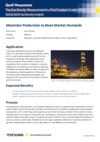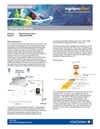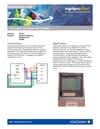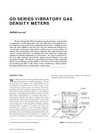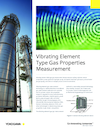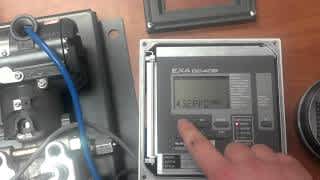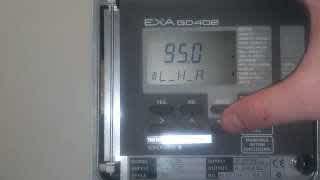The GD402 gas density analyzer and GD40 gas density detector provide continuous measurement of gas density as well as other valuable parameters, including specific gravity and percent concentration.
In applications where accurate, repeatable measurement of gas density is essential, Yokogawa’s family of gas density products deliver superior performance and reliability. From blending of fuel and product quality to hydrogen purity and replacement in utility turbines, our gas density analyzers provide accurate measurements with ease of maintenance and operability.
System
GD402 Analyzer
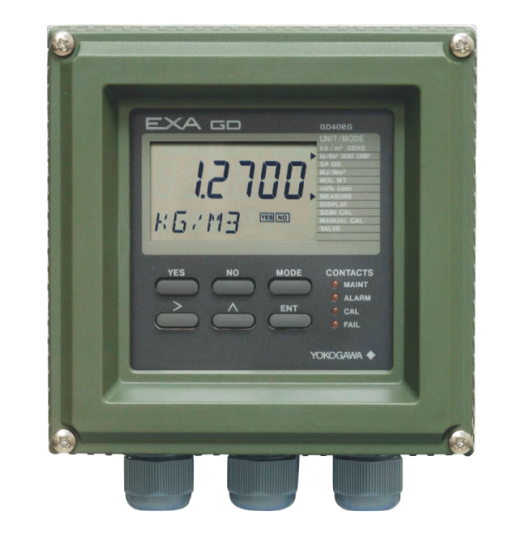 The GD402 is a rugged microprocessor-based converter designed in two versions to meet both general area and explosion-proof application requirements. In addition to the display of several key data items, the converter also provides the choice of three different means for calibration: automatic, semi-automatic, and one-touch manual operation. Features of the GD402 include:
The GD402 is a rugged microprocessor-based converter designed in two versions to meet both general area and explosion-proof application requirements. In addition to the display of several key data items, the converter also provides the choice of three different means for calibration: automatic, semi-automatic, and one-touch manual operation. Features of the GD402 include:
- Proven Design
- Many detector features
- Simple interface
- Low installation cost
GD40 Detector
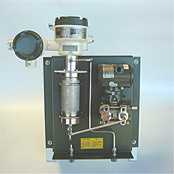 The GD40 detector is designed for intrinsically safe and flameproof, explosion protected applications. It is designed to be virtually maintenance free for all accepted applications. Features of the GD40 include:
The GD40 detector is designed for intrinsically safe and flameproof, explosion protected applications. It is designed to be virtually maintenance free for all accepted applications. Features of the GD40 include:
- Low installation cost
- Virtually maintenance free
- Not affected by dust or oil mist
Features
Robust Measurement Technology
A vibrating spool within the analyzer is resistant to contaminant build up and can survive being filled with liquid, resulting in increased measurement availability and process uptime. In addition, low maintenance is required with no replacement parts and no specialty gases to calibrate.
Unlike other density meters, the GD does not require the use of utilities such as heating or reference air, reducing operation costs and system complexity.

Resources
The top gas generated at the top of a distillation column in a petroleum refinery's fluid catalytic cracker (FCC) is used to produce gasoline and LPG. The GD402 Gas Density Meter features an intrinsically safe and explosion-proof design, fast response, and a dust-proof, anti-corrosive, and flame-proof construction.
In the manufacturing of Glass-Fiber wool for insulation a melt of a material such as glass is inductively heated at a stage intermediate an initial liquefying stage and a refining stage. Induction heating is the process of heating an electrically conducting object (usually a metal) by electromagnetic induction, where eddy currents are generated within the metal and resistance leads to Joule heating of the metal.
A major power company in the Southeast decided to replace its hydrogen gas detection system. The current system was unsupported by the manufacturer and failing. The new system would need to duplicate the functionality of the old to minimize the training and impact on the operators. Yokogawa was asked to facilitate the project.
Liquefied Petroleum Gas (LPG), or also known as LP Gas or auto gas, is a mixture of hydrocarbon gases used as a fuel in heating appliances and vehicles, and increasing replacing chlorofluorocarbons as an aerosol propellant and a refrigerant to reduce damage to the ozone layer.
The U.S. refineries represent approximately 23 percent of the world's petroleum production, and the United States has the largest refining capacity in the world. Petroleum refining is an industry, which is undergoing intense amounts of scrutiny in the United States from regulatory agencies and environmental groups.
We rolled out the first vibratory gas density meter ten years ago and since then have continued supplying it. The past ten years have seen changes in the target applications and requirements for functions that have made it easier to use.
Vibrating element (VBE) type gas measurement devices measure refinery reformer stream compositions, power generator hydrogen purity, centripetal compressor gas inputs, process heater fuel gas quality, and others in multiple process control environments.
Downloads
Brochures
- Gas Density GD402 (288 KB)
- GD402 Gas Density (396 KB)
- GD402 Gas Density - Spanish (1.5 MB)
- GD402 Hydrogen Purity (2.4 MB)
- GD402 Hydrogen Purity - Spanish (1.2 MB)
- GD402/GD40 Hydrogen Purity Monitor (1.7 MB)
Instruction Manuals
General Specifications
- GD402, GD40 Gas Density Meter (984 KB)
Technical Information
Engineering Tools
- Gas Density Meter Detector (59 KB)
Videos
Pairing a GD40G/GD402G gas density detector with the gas density analyzer.
This video shows you how to set the unit up the GD402G for hydrogen purity measurement.
Looking for more information on our people, technology and solutions?
Contact Us

